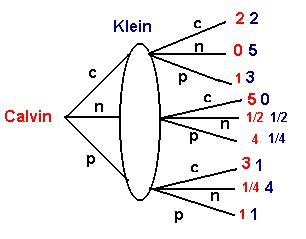
An Introduction to Game Theory
Game Theory: A formal way to analyze interaction among a group of rational agents who behave strategically.
Strategic interactions in which we can use game theory: Voting, auctions, bankruptcy, R&D races, cartel behavior, and more. In these 'game' situations we need to ask:
There are two formal representations for presenting our concept of a game:
1. The three contributions of von Neumann and Morgenstern.
2. John Nash's contribution.
3. Selten's contribution
4. Harsanyi's contribution.
A prisoner's dilemma in strategic form
Calvin and Klein have been arrested for theft of good taste in fashion. They are being held in separate cells in the jail with no way to communicate with one another. In their interrogation they have been presented with the following table:
Klein |
||||
| Confess | No Confession | Partly | ||
Calvin |
Confess | 2, 2 | 0, 5 | 1, 3 |
| No Confession | 5, 0 | 1/2, 1/2 | 4, 1/4 | |
| Partly | 3, 1 | 1/4, 4 | 1, 1 | |
If they both confess to the crime then they will both go to jail for 2 years. Calvin can cut a deal: If he confesses and Klein does not, then Calvin's confession can be used to sentence Klein to five years in jail and Calvin will walk. If Calvin gives a full confession but Klein only admits complicity then Calvin gets a year and Klein is sentenced to three. The rest of the table is read the same way.
Questions to ponder about this game:
A prisoner's dilemma in extensive form
The same game can be drawn in extensive form.

In addition to the questions of who, what and when, there are a couple of other things to think about when looking at this tree diagram: